Global Dermatology Devices Market, By Product Type, By Indication, By End-User, By Region & Segmental Insights Trends and Forecast, 2024 – 2034
- Industry: Healthcare
- Report ID: TNR-110-1174
- Number of Pages: 420
- Table/Charts : Yes
- June, 2024
- Base Year : 2024
- No. of Companies : 10+
- No. of Countries : 29
- Views : 10124
- Covid Impact Covered: Yes
- War Impact Covered: Yes
- Formats : PDF, Excel, PPT
Dermatology devices encompass a broad range of medical tools and equipment specifically designed for diagnosing, treating, and managing skin conditions and diseases. These devices include lasers, light therapy systems, microdermabrasion tools, and diagnostic imaging equipment. They play a crucial role in both clinical and cosmetic dermatology, addressing issues such as acne, psoriasis, skin cancer, and the effects of aging.
Advanced dermatology devices enable precise treatments with minimal invasiveness, improving patient outcomes and satisfaction. Innovations in this field have led to more effective, efficient, and safer procedures, making dermatological care more accessible and comprehensive. As the demand for aesthetic enhancements and effective skin treatments continues to grow, the importance and utilization of dermatology devices are increasingly paramount in modern medical practice.
The demand for dermatology devices is propelled by several significant factors, reflecting the growing emphasis on skin health and aesthetic enhancement. The rising prevalence of skin conditions such as acne, eczema, and skin cancer necessitate advanced diagnostic and therapeutic tools, fostering a robust market for these devices. Additionally, the increasing awareness and acceptance of cosmetic dermatology drive the demand for treatments like laser hair removal, skin resurfacing, and anti-aging procedures. Technological advancements have led to the development of more effective, minimally invasive devices, enhancing patient outcomes and satisfaction.
Furthermore, the expanding aging population seeks solutions to maintain youthful skin, contributing to the market’s growth. Social media and celebrity endorsements also play a crucial role, influencing consumer preferences and boosting demand for dermatological treatments. Finally, higher disposable incomes and the growing trend of medical tourism, where patients seek quality care at affordable prices, further drive the demand for sophisticated dermatology devices globally.
In terms of revenue, the global dermatology devices market was worth US$ 15.5 Bn in 2023, anticipated to witness CAGR of 13.2% during 2024 – 2034.
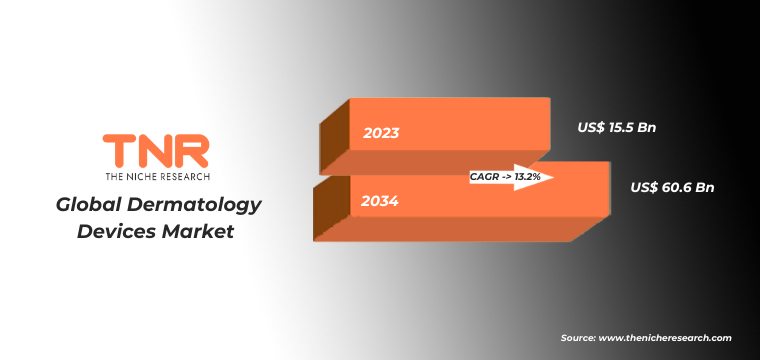
Trends in the Global Dermatology Devices Market
Technological Advancements: Continuous innovation in dermatology devices has led to the development of more effective, less invasive treatments. This includes advancements in laser technology, radiofrequency devices, and AI-powered diagnostic tools. These innovations provide more precise and quicker treatments, enhancing patient outcomes and satisfaction.
Rising Demand for Aesthetic Procedures: The increasing focus on aesthetic appeal and anti-aging treatments has significantly boosted demand for dermatology devices. Procedures such as laser hair removal, skin tightening, and wrinkle reduction are becoming more popular, driven by societal trends and the influence of social media.
Growth in Medical Tourism: Many patients are traveling abroad to access high-quality dermatological treatments at lower costs. This trend is particularly noticeable in countries known for their advanced healthcare systems and cost-effective services, driving the global demand for dermatology devices.
Increase in Skin Cancer Cases: The rising incidence of skin cancer and other skin-related conditions necessitates advanced diagnostic and treatment devices. Early detection and effective treatment options are critical, prompting healthcare providers to invest in cutting-edge dermatology devices.
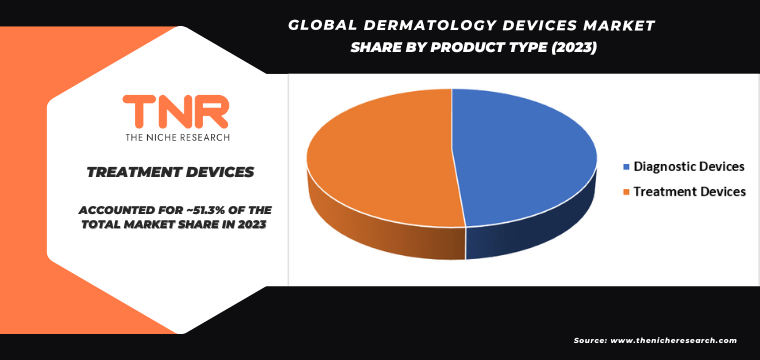
Hair Removal had the Highest Share in the Global Dermatology Devices Market in 2023.
Growing preference for non-invasive and long-lasting hair removal solutions, such as laser and intense pulsed light (IPL) treatments, over traditional methods like shaving and waxing. Advances in technology have made these procedures more accessible, efficient, and safer, attracting a diverse range of consumers seeking convenience and effectiveness. Additionally, rising awareness about personal grooming and aesthetic appeal, fueled by social media and celebrity influence, significantly boosts market demand.
The expanding disposable income and willingness to invest in cosmetic procedures further propel this trend. Furthermore, the desire for smooth, hair-free skin among both men and women is becoming increasingly mainstream, leading to higher adoption rates of dermatology devices in professional and home-use settings. Overall, these factors collectively drive the robust growth and innovation in the hair removal dermatology device market.
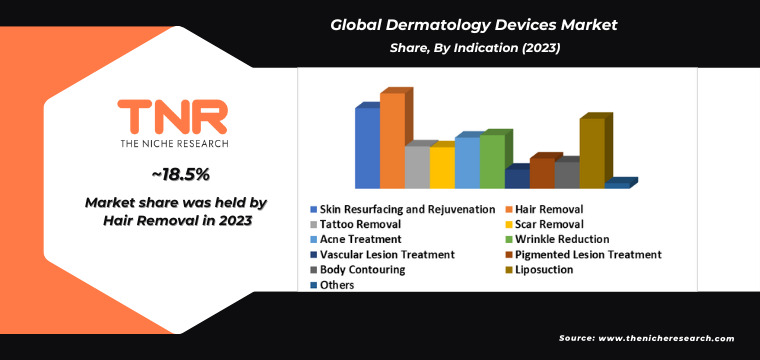
By End User Cosmetics Centers is Projected as the Fastest Growing Segment in the Global Dermatology Devices Market in 2023.
The increasing popularity of cosmetic centers is significantly driving the demand for dermatology devices. This growth is primarily fueled by the growing consumer desire for aesthetic enhancements and anti-aging treatments, such as laser therapies, chemical peels, and microdermabrasion. Advances in dermatological technology have made these procedures safer, more effective, and less invasive, attracting a broader clientele. Additionally, the rise in disposable income and heightened awareness of skin health and appearance contribute to this trend. Social media and celebrity endorsements further boost demand as people seek to emulate flawless looks.
Furthermore, an aging population keen on maintaining a youthful appearance and the expansion of medical tourism to regions with high-quality yet affordable treatments amplify the need for sophisticated dermatology devices. Consequently, cosmetic centers are investing heavily in advanced dermatological equipment to meet this growing demand, driving innovation and market growth.
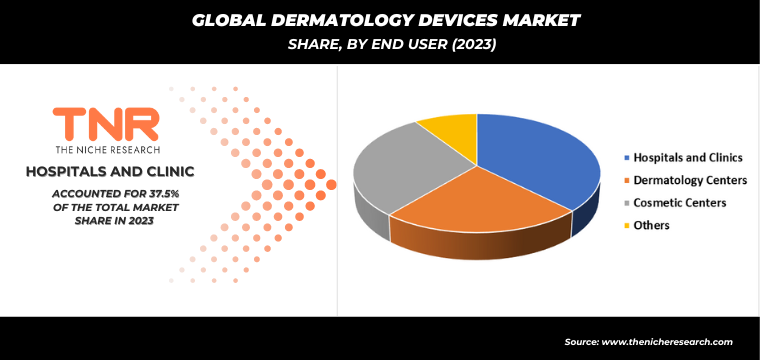
By Region, North America Dominated the Global Dermatology Devices Market in 2023.
The demand for dermatology devices in North America is driven by several key factors, including the rising prevalence of skin conditions such as acne, eczema, and psoriasis, which necessitates advanced diagnostic and treatment solutions. Additionally, an aging population increasingly seeks anti-aging treatments, fuelling the market for devices like laser therapies and microdermabrasion. The growing awareness and acceptance of aesthetic procedures, coupled with the expansion of medical tourism, further bolster the demand for sophisticated dermatological equipment.
Technological advancements in dermatology devices, offering minimally invasive and more effective treatment options, also play a crucial role in driving market growth. Moreover, increasing disposable incomes and a heightened focus on personal appearance contribute to the escalating use of dermatology devices. Overall, these demand drivers collectively enhance the dermatology device market’s expansion across North America, reflecting a robust and dynamic industry outlook. Additionally, the aesthetic dermatology segment is booming, with over 18 million minimally invasive cosmetic procedures performed in 2022, reflecting a strong consumer preference for treatments like laser therapy and Botox.
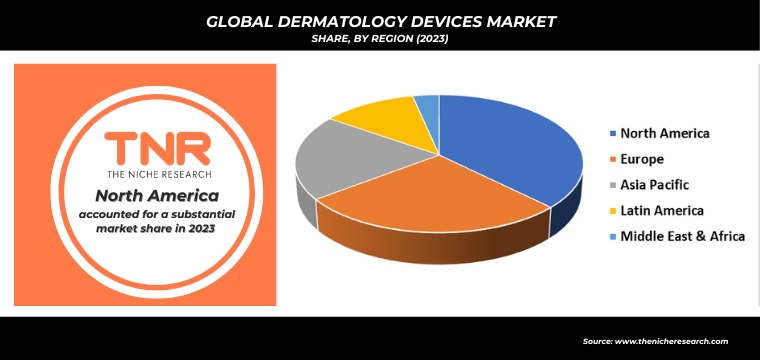
Competitive Landscape
Some of the players operating in the global dermatology devices market are
- Alma Lasers
- Ambicare Health
- Bausch Health Companies Inc.
- Bruker Corporation
- Candela Corporation
- Canfield Scientific, Inc.
- Cutera, Inc.
- Cynosure, Inc.
- DermLite
- Genesis Biosystems, Inc.
- HEINE Optotechnik GmbH & Co. KG
- Image Derm, Inc.
- Lumenis Be Ltd.
- Photomedex, Inc.
- Solta Medical, Inc.
- Other Industry Participants
Global Dermatology Devices Market Scope
| Report Specifications | Details |
| Market Revenue in 2023 | US$ 15.5 Bn |
| Market Size Forecast by 2034 | US$ 60.6 Bn |
| Growth Rate (CAGR) | 13.2% |
| Historic Data | 2016 – 2022 |
| Base Year for Estimation | 2023 |
| Forecast Period | 2024 – 2034 |
| Report Inclusions | Market Size & Estimates, Market Dynamics, Competitive Scenario, Trends, Growth Factors, Market Determinants, Key Investment Segmentation, Product/Service/Solutions Benchmarking |
| Segments Covered | By Product Type, By Indication, By End-User, By Region |
| Regions Covered | North America, Europe, Asia Pacific, Middle East & Africa, Latin America |
| Countries Covered | U.S., Canada, Mexico, Rest of North America, France, The UK, Spain, Germany, Italy, Nordic Countries (Denmark, Finland, Iceland, Sweden, Norway), Benelux Union (Belgium, The Netherlands, Luxembourg), Rest of Europe, China, Japan, India, New Zealand, Australia, South Korea, Southeast Asia (Indonesia, Thailand, Malaysia, Singapore, Rest of Southeast Asia), Rest of Asia Pacific, Saudi Arabia, UAE, Egypt, Kuwait, South Africa, Rest of Middle East & Africa, Brazil, Argentina, Rest of Latin America |
| Key Players | Alma Lasers, Ambicare Health, Bausch Health Companies Inc., Bruker Corporation, Candela Corporation, Canfield Scientific, Inc., Cutera, Inc., Cynosure, Inc., DermLite, Genesis Biosystems, Inc., HEINE Optotechnik GmbH & Co. KG, Image Derm, Inc., Lumenis Be Ltd., Photomedex, Inc., Solta Medical, Inc. |
| Customization Scope | Customization allows for the inclusion/modification of content pertaining to geographical regions, countries, and specific market segments. |
| Pricing & Procurement Options | Explore purchase options tailored to your specific research requirements |
| Contact Details | Consult With Our Expert
Japan (Toll-Free): +81 663-386-8111 South Korea (Toll-Free): +82-808- 703-126 Saudi Arabia (Toll-Free): +966 800-850-1643 United Kingdom: +44 753-710-5080 United States: +1 302-232-5106 E-mail: askanexpert@thenicheresearch.com
|
Global Dermatology Devices Market
By Product Type
- Diagnostic Devices
- Dermatoscopes
- Microscopes
- Imaging Devices
- Treatment Devices
- Lasers
- Light Therapy Devices
- Cryotherapy Devices
- Electrosurgical Equipment
- Microdermabrasion Devices
- Dermabrasion Devices
- Liposuction Devices
- Others
By Indication
- Skin Resurfacing and Rejuvenation
- Hair Removal
- Tattoo Removal
- Scar Removal
- Acne Treatment
- Wrinkle Reduction
- Vascular Lesion Treatment
- Pigmented Lesion Treatment
- Body Contouring
- Liposuction
- Others
By End User
- Hospitals and Clinics
- Dermatology Centers
- Cosmetic Centers
- Others
By Region
- North America (U.S., Canada, Mexico, Rest of North America)
- Europe (France, The UK, Spain, Germany, Italy, Nordic Countries (Denmark, Finland, Iceland, Sweden, Norway), Benelux Union (Belgium, The Netherlands, Luxembourg), Rest of Europe)
- Asia Pacific (China, Japan, India, New Zealand, Australia, South Korea, Southeast Asia (Indonesia, Thailand, Malaysia, Singapore, Rest of Southeast Asia), Rest of Asia Pacific)
- Middle East & Africa (Saudi Arabia, UAE, Egypt, Kuwait, South Africa, Rest of Middle East & Africa)
- Latin America (Brazil, Argentina, Rest of Latin America)
Report Layout:
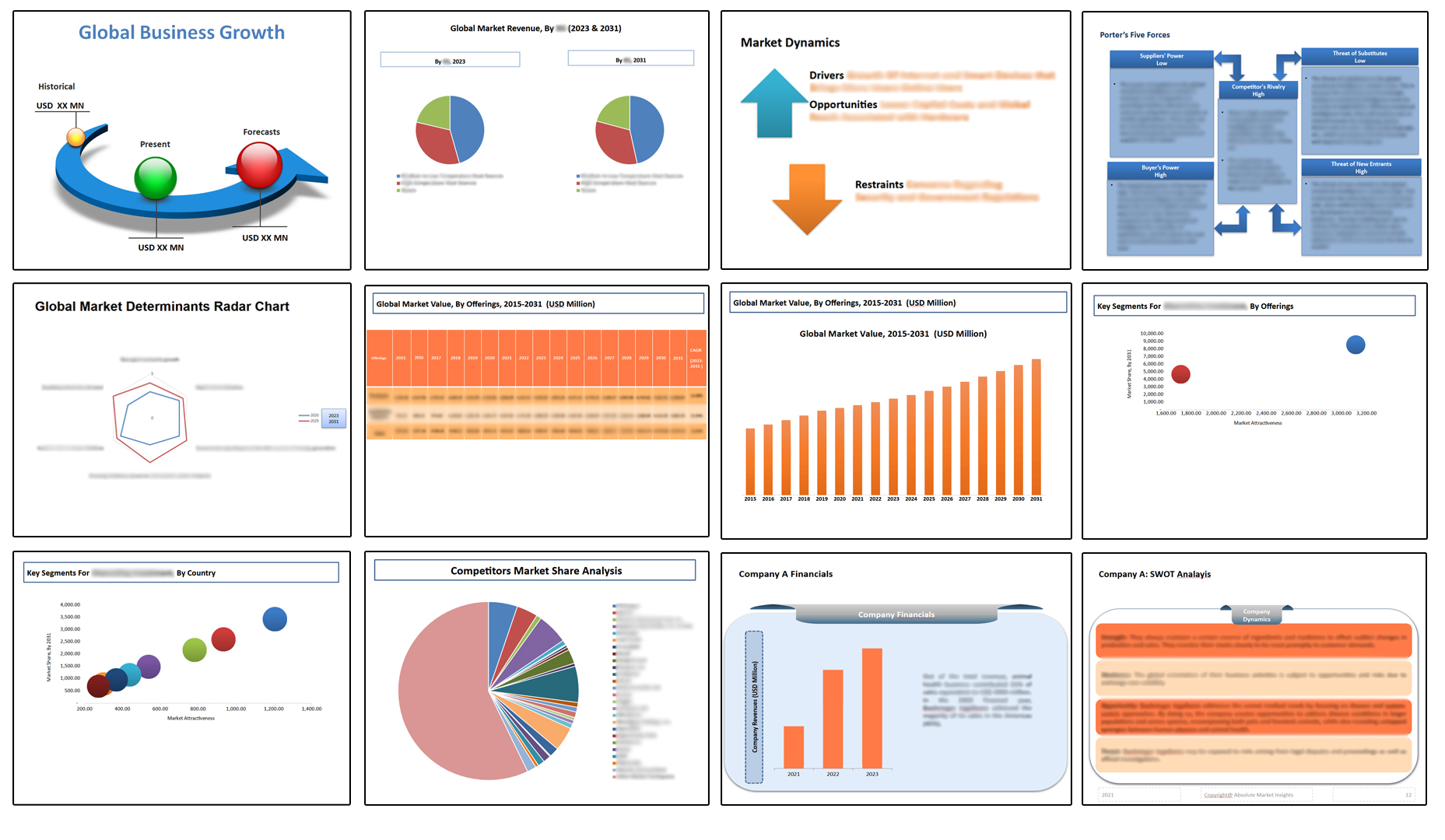
Table of Contents
Note: This ToC is tentative and can be changed according to the research study conducted during the course of report completion.
**Exclusive for Multi-User and Enterprise User.
Global Dermatology Devices Market
By Product Type
- Diagnostic Devices
- Dermatoscopes
- Microscopes
- Imaging Devices
- Treatment Devices
- Lasers
- Light Therapy Devices
- Cryotherapy Devices
- Electrosurgical Equipment
- Microdermabrasion Devices
- Dermabrasion Devices
- Liposuction Devices
- Others
By Indication
- Skin Resurfacing and Rejuvenation
- Hair Removal
- Tattoo Removal
- Scar Removal
- Acne Treatment
- Wrinkle Reduction
- Vascular Lesion Treatment
- Pigmented Lesion Treatment
- Body Contouring
- Liposuction
- Others
By End User
- Hospitals and Clinics
- Dermatology Centers
- Cosmetic Centers
- Others
By Region
- North America (U.S., Canada, Mexico, Rest of North America)
- Europe (France, The UK, Spain, Germany, Italy, Nordic Countries (Denmark, Finland, Iceland, Sweden, Norway), Benelux Union (Belgium, The Netherlands, Luxembourg), Rest of Europe)
- Asia Pacific (China, Japan, India, New Zealand, Australia, South Korea, Southeast Asia (Indonesia, Thailand, Malaysia, Singapore, Rest of Southeast Asia), Rest of Asia Pacific)
- Middle East & Africa (Saudi Arabia, UAE, Egypt, Kuwait, South Africa, Rest of Middle East & Africa)
- Latin America (Brazil, Argentina, Rest of Latin America)
The Niche Research approach encompasses both primary and secondary research methods to provide comprehensive insights. While primary research is the cornerstone of our studies, we also incorporate secondary research sources such as company annual reports, premium industry databases, press releases, industry journals, and white papers.
Within our primary research, we actively engage with various industry stakeholders, conducting paid interviews and surveys. Our meticulous analysis extends to every market participant in major countries, allowing us to thoroughly examine their portfolios, calculate market shares, and segment revenues.
Our data collection primarily focuses on individual countries within our research scope, enabling us to estimate regional market sizes. Typically, we employ a bottom-up approach, meticulously tracking trends in different countries. We analyze growth drivers, constraints, technological innovations, and opportunities for each country, ultimately arriving at regional figures.Our process begins by examining the growth prospects of each country. Building upon these insights, we project growth and trends for the entire region. Finally, we utilize our proprietary model to refine estimations and forecasts.
Our data validation standards are integral to ensuring the reliability and accuracy of our research findings. Here’s a breakdown of our data validation processes and the stakeholders we engage with during our primary research:
- Supply Side Analysis: We initiate a supply side analysis by directly contacting market participants, through telephonic interviews and questionnaires containing both open-ended and close-ended questions. We gather information on their portfolios, segment revenues, developments, and growth strategies.
- Demand Side Analysis: To gain insights into adoption trends and consumer preferences, we reach out to target customers and users (non-vendors). This information forms a vital part of the qualitative analysis section of our reports, covering market dynamics, adoption trends, consumer behavior, spending patterns, and other related aspects.
- Consultant Insights: We tap into the expertise of our partner consultants from around the world to obtain their unique viewpoints and perspectives. Their insights contribute to a well-rounded understanding of the markets under investigation.
- In-House Validation: To ensure data accuracy and reliability, we conduct cross-validation of data points and information through our in-house team of consultants and utilize advanced data modeling tools for thorough verification.
The forecasts we provide are based on a comprehensive assessment of various factors, including:
- Market Trends and Past Performance (Last Five Years): We accurately analyze market trends and performance data from preceding five years to identify historical patterns and understand the market’s evolution.
- Historical Performance and Growth of Market Participants: We assess the historical performance and growth trajectories of key market participants. This analysis provides insights into the competitive landscape and individual company strategies.
- Market Determinants Impact Analysis (Next Eight Years): We conduct a rigorous analysis of the factors that are projected to influence the market over the next eight years. This includes assessing both internal and external determinants that can shape market dynamics.
- Drivers and Challenges for the Forecast Period:Identify the factors expected to drive market growth during the forecast period, as well as the challenges that the industry may face. This analysis aids in deriving an accurate growth rate projection.
- New Acquisitions, Collaborations, or Partnerships: We keep a close watch on any new acquisitions, collaborations, or partnerships within the industry. These developments can have a significant impact on market dynamics and competitiveness.
- Macro and Micro Factors Analysis:A thorough examination of both macro-level factors (e.g., economic trends, regulatory changes) and micro-level factors (e.g., technological advancements, consumer preferences) that may influence the market during the forecast period.
- End-User Sentiment Analysis: To understand the market from the end-user perspective, we conduct sentiment analysis. This involves assessing the sentiment, preferences, and feedback of the end-users, which can provide valuable insights into market trends.
- Perspective of Primary Participants: Insights gathered directly from primary research participants play a crucial role in shaping our forecasts. Their perspectives and experiences provide valuable qualitative data.
- Year-on-Year Growth Trend: We utilize a year-on-year growth trend based on historical market growth and expected future trends. This helps in formulating our growth projections, aligning them with the market’s historical performance.
Research process adopted by TNR involves multiple stages, including data collection, validation, quality checks, and presentation. It’s crucial that the data and information we provide add value to your existing market understanding and expertise. We have also established partnerships with business consulting, research, and survey organizations across regions and globally to collaborate on regional analysis and data validation, ensuring the highest level of accuracy and reliability in our reports.









